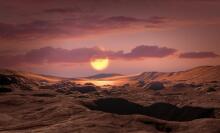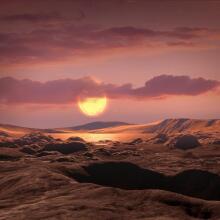Sometimes, planets go rogue.
Scientists used the powerful James Webb Space Telescope to spot six of these rogue objects, which move through the cosmos untethered from any solar system. They're a little bigger than the gas giant Jupiter, and the discovery suggests these worlds formed similar to the way stars form — rather than how planets are usually created.
Astronomers have waited for years to harness the abilities of the Webb telescope, whose large mirror gathers bounties of distant, faint light, to find such free-floating objects.
"It has been in planning for a decade," Ray Jayawardhana, an astronomer at Johns Hopkins University and senior author of the study, told Mashable.
You can see three of these rogue planets below, circled in green. They're located about 1,000 light-years away in our galaxy, inhabiting the nebula NGC1333, an enormous region of dust and gas where stars form.
"It has been in planning for a decade."
Although it's possible they originally formed as planets around a star, the researchers think they're more likely failed stars — but didn't have nearly the mass needed to ignite a stellar engine like our sun. (Stars form when enormous clouds of gas collapse and heat up, ultimately creating the immense pressure and heat needed for star creation.) The lowest-mass object found, about five times the mass of Jupiter, shows evidence of a dusty disk around it, and space dust often spins around a central object amid star formation. What's more, it's hard to imagine a planet getting ejected from its solar system and maintaining such a disk.
"The objects more likely formed how stars formed," Rayawardhana said.
The research has been accepted for publication in The Astronomical Journal, a peer-reviewed science chronicle.

The rogue objects are similar in mass to other large gaseous planets found beyond our solar system, called exoplanets. If they aren't failed stars, these objects would have needed to get thrown out of their solar system, perhaps by a close gravitational interaction with another planet, or a second star (most solar systems have two or more stars).
The investigation of rogue objects continues. The astronomers have been awarded more competitive time with the Webb telescope to peer at such objects with dusty disks. Could they be "mini-planetary" systems like the many curious moons orbiting Saturn and Jupiter? As we know in our own solar system, these planetary systems include intriguing moons, some of which harbor oceans beneath their icy shells.
A bonus sighting: Although not a part of this research endeavor, the Webb image above shows telltale evidence of a newly forming solar system. Look near the bottom right, below the black bar, where you can see two dark cone-like features emanating from a bright central spot. That's Webb, from our perch in the Milky Way galaxy, viewing the dusty disk of the solar system side-on, as we might view the side of a frisbee. The nascent system's dust-filled disk blocks starlight, creating those two dark flares.
The Webb telescope's powerful abilities
The Webb telescope — a scientific collaboration between NASA, ESA, and the Canadian Space Agency — is designed to peer into the deepest cosmos and reveal new insights about the early universe. But it's also peering at intriguing planets in our galaxy, along with the planets and moons in our solar system.
Here's how Webb is achieving unparalleled feats, and likely will for decades to come:
- Giant mirror: Webb's mirror, which captures light, is over 21 feet across. That's over two-and-a-half times larger than the Hubble Space Telescope's mirror. Capturing more light allows Webb to see more distant, ancient objects. As described above, the telescope is peering at stars and galaxies that formed over 13 billion years ago, just a few hundred million years after the Big Bang. "We're going to see the very first stars and galaxies that ever formed," Jean Creighton, an astronomer and the director of the Manfred Olson Planetarium at the University of Wisconsin–Milwaukee, told Mashable in 2021.
- Infrared view: Unlike Hubble, which largely views light that's visible to us, Webb is primarily an infrared telescope, meaning it views light in the infrared spectrum. This allows us to see far more of the universe. Infrared has longer wavelengths than visible light, so the light waves more efficiently slip through cosmic clouds; the light doesn't as often collide with and get scattered by these densely packed particles. Ultimately, Webb's infrared eyesight can penetrate places Hubble can't.
"It lifts the veil," said Creighton.
- Peering into distant exoplanets: The Webb telescope carries specialized equipment called spectrographs that will revolutionize our understanding of these far-off worlds. The instruments can decipher what molecules (such as water, carbon dioxide, and methane) exist in the atmospheres of distant exoplanets — be they gas giants or smaller rocky worlds. Webb looks at exoplanets in the Milky Way galaxy. Who knows what we'll find?
"We might learn things we never thought about," Mercedes López-Morales, an exoplanet researcher and astrophysicist at the Center for Astrophysics-Harvard & Smithsonian, told Mashable in 2021.
Already, astronomers have successfully found intriguing chemical reactions on a planet 700 light-years away, and have started looking at one of the most anticipated places in the cosmos: the rocky, Earth-sized planets of the TRAPPIST solar system.
Topics NASA













